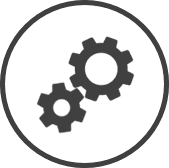Waste Categories is one of two forms of waste management available in CLEARVIEW. Waste Categories lets you create items that you can then use to report wastage.
Raw and Completed is the other form of waste management and it automatically assigns all active inventory items (from the Inventory Item Master List) to the raw list, and all active menu items (from Menu Items) to the completed list.
The form of waste management used by your organization is determined by the Waste Entry Method.
Click here to learn how to select the Waste Entry Method in Inventory Reporting.
To access Waste Categories settings:
-
Click on
 on the quick links Located at the top right corner of a page, it contains icons that allow you to quickly access important pages. bar from any page.
on the quick links Located at the top right corner of a page, it contains icons that allow you to quickly access important pages. bar from any page. -
In the Settings window:
Settings associated to a page automatically show in the List box. If the setting that you want to access is in the List box, you can skip step a.
-
Select Inventory from the Filter drop-down list.
-
Click on Waste Categories from the List box in the left pane.
-
The Waste Entry Method in Inventory Reporting must be set to Waste Categories in order to access these settings.
Click here to learn how to change the Waste Entry Method in Inventory Reporting.
The following information is displayed on the settings page:
-
Active: If the box is checked the waste category is presently active and if it isn't check it's presently inactive.
-
Category Description: The name of the waste category.
-
Unit Type: The description of a single quantity of the waste category.
-
Sequence: The order in which the categories will appear on the Daily Waste and Weekly Waste pages. Waste categories with the same sequence number will be displayed in alphabetical order.
-
Audit: An Audit button in this column indicates that the record was edited.
Click on the Audit button to see the changes made to the waste item.
Each waste category has a Cost Information/Method (click on the name of a waste category to open the Update Waste Category window and view the Cost Information/Method) assigned to it:
-
Recipe: The wasted item (also known as waste category) is a combination of inventory items and is hence mapped to a recipe. When the item is wasted, all ingredients from the recipe are wasted as per the quantity set in the recipe. The cost of the wasted item will hence be the cost of all the ingredients (inventory items) that went into it.
-
Inventory Item: The wasted item/category is an inventory item (single item with no ingredients). The cost of the wasted item is hence derived from the cost of the mapped inventory item.
-
Fixed Cost per Unit: The cost of the waste item/category will always be fixed as the amount entered in this field
When the Cost Information/Method for an item is set to Fixed Cost per Unit, the wasted item/category will have no effect on inventory levels and the purchase cost is not taken into consideration.
Related CLEARVIEW Pages
*optional section or field that may or may not be visible depending on the settings selected, whether the supplier is integrated or not, etc.



